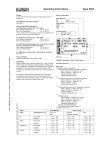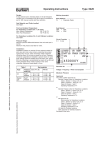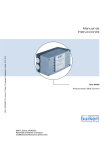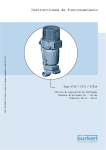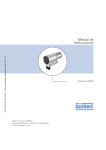Download Operating Instructions Type 0311/0312
Transcript
Operating Instructions Design: 2-way solenoid valve, direct acting, normally closed (Circuit function C), normally open (Circuit function D) or mixer function (Circuit function E). Seal Materials and Fluids handled: See Table. Fluid and Ambient Temperature: For Hazardous Locations Div. 1 (T4 rated) Max. Ambient Temperature 104 °F (40 °C) Max. Fluid Temperature 194 °F (90 °C) For Hazardous Locations Div. 1 (T6 rated) Max. Ambient Temperature 104 °F (40 °C) Max. Fluid Temperature 140 °F (60 °C) For Hazardous Locations Div. 2 and Ordinary Locations: See Table. Pressure Range: Maximum inlet pressure see label on valve. Installation: Before installing valve ensure that piping etc. is free of foreign matter (metal fillings, seal materials, welding scale etc.). Installation as required but preferably with coil uppermost. Installation in this position tends to prevent foreign matter remaining in core tube (increased life). Do not put any loads on coil unit. Type 0311/0312 Approvals The valve is either approved as General Purpose valve for Hazardous Locations Class I, Division 1, Group A, B, C, D Class II, Division 1, Group E, F, G Class III, Division 1 and 2 Operating Temperature T 4 or General Purpose valve for Hazardous Locations Class I, Division 1, Group A, B, C, D Class II, Division 1, Group E, F, G Class III, Division 1 and 2 Operating Temperature T 6 or FM approved as Nonincendive for Hazardous Locations Class I, Division 2, Group A, B, C, D Class II, Division 2, Group F, G Class III, Division 1 and 2 Operating Temperature T 4 UL listed for Ordinary locations CSA approved for Ordinary locations See label on the valve. Marking (example): Type 0311: PTFE tape is recommended for sealing ports. Mounting is accomplished by means of four M4 x 8 mm tapped holes located on the valve underside. Circuit function C = Normally Closed D = Normally Open E = Mixer Function Type 0312: Ports A (B) are coded on side of body. For common pressure, align "A (B)" marking on valve and manifold. Valve operation C and D valves cannot be manifolded together. To remove valve from manifold loosen only the two unsealed screws. Manifolds can be connected togehter with nipples. Seal Material EPDM NBR FKM EA EF NN RF = = = = = = = EPDM NBR FKM PTFE seat and EPDM O-ring PTFE seat and FKM O-ring Neoprene Ruby seat and FKM O-ring Body Material BR SS NI PL = = = = Brass Stainless Steel Nickel Plated Brass Polyamide Plastic Maximum Pressure Voltage / Frequency / Power Consumption Operating Instructions 0605/08_EU-EN_00893135 Recorder No. Seal Materials Seat / O-ring Fluid Temperatures [° F] Buna „N‰ Ethylene Propylene FKM PTFE/ Ethylene Propyl. PTFE/ FKM Air Fluid T. Ambient +14 to +194 +14 to +130 - 40 to +266 +14 to +130 +14 to +266 +14 to +130 +14 to +266 +14 to +130 +14 to +266 +14 to +130 Water Fluid T. Ambient +32 to +194 +32 to +130 +32 to +212 +32 to +130 +32 to +212 +32 to +130 +32 to +212 +32 to +130 +32 to +212 +32 to +130 Neutral Gas Fluid T. Ambient +14 to +194 +14 to +130 - 40 to +266 +14 to +130 +14 to +266 +14 to +130 +14 to +266 +14 to +130 +14 to +266 +14 to +130 Light oil Fluid T. Ambient +14 to +194 +14 to +130 +14 to +266 +14 to +130 +14 to +266 +14 to +130 LP-gas Fluid T. Ambient +14 to +140 +14 to +130 +14 to +140 +14 to +130 +14 to +140 +14 to +130 Refrigerants Fluid T. Ambient Neoprene +14 to +194 +14 to +130 Operating Instructions For this product to be considered UL-listed and CSA approved for General Purpose and FM approved for Hazardous Locations Division 2, it must be in conjunction with the type 2509 cable plug connector (Electrically Operated Valves Parts, YSYI2). The connector and gasket must be assembled to the valve with the screw provided after the connection of the wire leads. This valve and connector assembly is delivered together and is to be used as one unit. Wiring Diagram Electrical Connection Type 2509 For valves to be used in Intrinsically Safe Applications the positive pole is identified by a “+” on the pin or wire No. 1 has to be connected to the “+”. See Control Drawing for the Rules of Interconnection. Power* Ground (green dot) Warning: All valves to be used in Intrinsically Safe Applications must be clearly marked as Intrinsically Safe Apparatus. Trouble-Shooting: Check port connections, minimum operating pressure differential if required and supply voltage. Ensure pilot hole in piston is clear and pilot bore in the valve outlet is not abstracted. If core does not pull in, check for short circuit, coil burn-out or foreign matter impeding core movement. A jammed or missing core causes the coil to overheat in the case of AC supply. Power* * Orientation is not important Electrical Connection: Ensure supply voltage/frequency corresponds with that on label. Voltage tolerance is ± 10 %. Available Electrical Connections see “Marking”. Wiring diagram see above. Warning: These products are designed to operate in a wide variety of applications, it is the user’s responsibility to select a model that is appropriate for the application. This product is designed to be installed only by suitably qualified and trained personnel. Specifications should not be exceeded under any circumstances. The torque for the terminal screw on type 2509 is 0,5 Nm (4,4 lbf-in.). Changes made to this product will render any applicable warranty null and avoid. Specifications subject to change without notice. Any questions? Please call Bürkert Contromatic Technical Service at (949) 223 31 00. Germany Contact address: Bürkert Fluid Control Systems Sales Center Chr.-Bürkert-Str. 13-17 D-74653 Ingelfingen Tel. + 49 (0) 7940 - 10 91 111 Fax + 49 (0) 7940 - 10 91 448 E-mail: [email protected] International Contact addresses can be found on the Internet at: www.burkert.com Bürkert Company Locations



